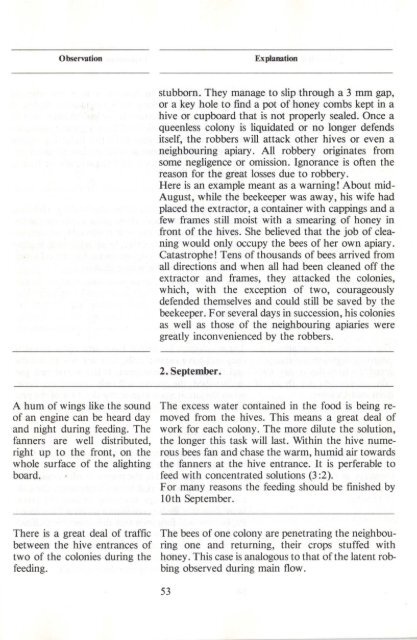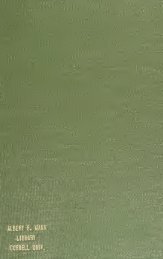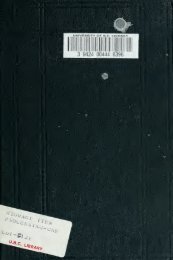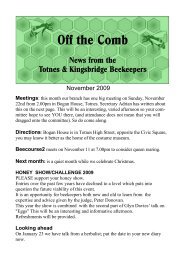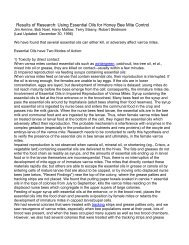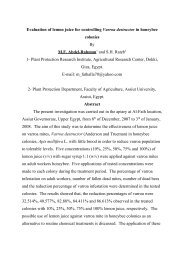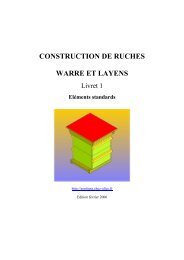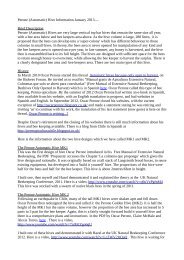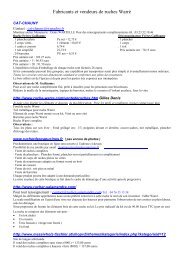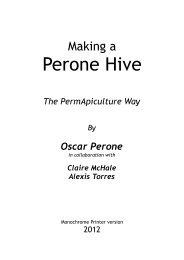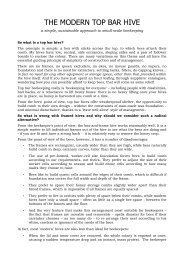You also want an ePaper? Increase the reach of your titles
YUMPU automatically turns print PDFs into web optimized ePapers that Google loves.
Observation<br />
Explanation<br />
stubborn. They manage to slip through a 3 mm gap,<br />
or a key hole to find a pot of honey combs kept in a<br />
hive or cupboard that is not properly sealed. Once a<br />
queenless colony is liquidated or no longer defends<br />
itself, <strong>the</strong> robbers will attack o<strong>the</strong>r hives or even a<br />
neighbouring apiary. All robbery originates from<br />
some negligence or omission. Ignorance is often <strong>the</strong><br />
reason for <strong>the</strong> great losses due to robbery.<br />
Here is an example meant as a warning! About mid<br />
August, while <strong>the</strong> beekeeper was away, his wife had<br />
placed <strong>the</strong> extractor, a container with cappings and a<br />
few frames still moist with a smearing of honey in<br />
front of <strong>the</strong> hives. She believed that <strong>the</strong> job of cleaning<br />
would only occupy <strong>the</strong> bees of her own apiary.<br />
Catastrophe! Tens of thousands of bees arrived from<br />
all directions and when all had been cleaned off <strong>the</strong><br />
extractor and frames, <strong>the</strong>y attacked <strong>the</strong> colonies,<br />
which, with <strong>the</strong> exception of two, courageously<br />
defended <strong>the</strong>mselves and could still be saved by <strong>the</strong><br />
beekeeper. F or several days in succession, his colonies<br />
as well as those of <strong>the</strong> neighbouring apiaries were<br />
greatly inconvenienced by <strong>the</strong> robbers.<br />
2. September.<br />
A hum of wings like <strong>the</strong> sound<br />
of an engine can be heard day<br />
and night during feeding. The<br />
fanners are well distributed,<br />
right up to <strong>the</strong> front, on <strong>the</strong><br />
whole surface of <strong>the</strong> alighting<br />
board.<br />
The excess water contained in <strong>the</strong> food is being removed<br />
from <strong>the</strong> hives. This means a great deal of<br />
work for each colony. The more dilute <strong>the</strong> solution,<br />
<strong>the</strong> longer this task will last. Within <strong>the</strong> hive numerous<br />
bees fan and chase <strong>the</strong> warm, humid air towards<br />
<strong>the</strong> fanners at <strong>the</strong> hive entrance. It is perferable to<br />
feed with concentrated solutions (3 :2).<br />
For many reasons <strong>the</strong> feeding should be finished by<br />
10th September.<br />
There is a great deal of traffic<br />
between <strong>the</strong> hive entrances of<br />
two of <strong>the</strong> colonies during <strong>the</strong><br />
feeding.<br />
The bees of one colony are penetrating <strong>the</strong> neighbouring<br />
one and returning, <strong>the</strong>ir crops stuffed with<br />
honey. This case is analogous to that of <strong>the</strong> latent robbing<br />
observed during main flow .<br />
53


